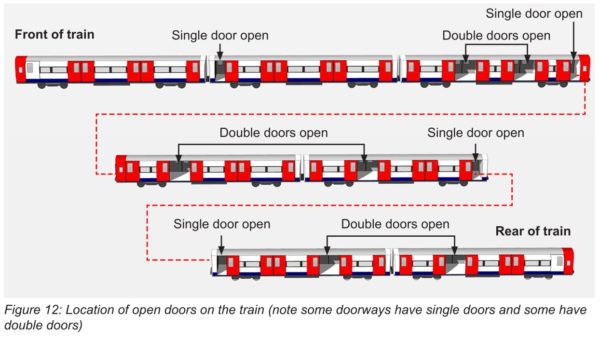Last September, a Jubilee line train was driven at over 60km/h between two stations with its doors open in several carriages, a report from the Rail Accident investigation has found.
An investigation by the Rail Accident Investigation Branch (RAIB) has not come to a conclusive decision about how the incident occured, but says that it was likely due to a mix of poor staff training and tiredness in the driver.
The driver, who has not been named, had been operating trains on the Jubilee line since December 2007, having joined London Underground as a station assistant in 1999. His most recent driving assessment before the incident was in July 2018 as part of his regular competence management cycle, and no problems were reported.
The incident took place on Saturday 1st September 2018 at 9am as the train arrived at Finchley Road station northbound under automatic train operation (ATO), and the doors opened without the driver pressing the necessary switch.
That was enough to indicate a problem with the train, and it might have been prudent to take it out of service. The OTDR, or “black box” then recorded all the actions taken by the driver to fix the problem.
It seems that while dealing with the door issue, the train operator operated a switch, bypassing the door interlock circuit that was intended to prevent the train from departing with doors open. Other trains would sound an alarm, but the Jubilee line trains didn’t. He then drives off to West Hampstead, unaware that the train had 10 doors still open.
During the trip, a passenger alarm was triggered, and when the driver discovered the problem, the train was taken out of service for investigation. Fortunately, the train was lightly used on a Saturday morning, and no one was hurt in the incident.
In the subsequent investigation, the driver said that he had ‘zoned out’ and made ‘rushed decisions’ when dealing with the door problems at Finchley Road.
The report by the RAIB suggests that the switching from automatic train operation at Finchley Road station along with the fault developing probably caused a sudden increase in the driver’s workload, and that he might have been tired from his sleep pattern as he had just 6 hours sleep the night before, or lack of food as he hadn’t eaten for 13 hours.
Hence his not noticing the problem when leaving Finchley Road station.
The RAIB has made four recommendations addressed to London Underground. These include improvements to door control systems on Jubilee line trains; better training to help train operators respond correctly when sudden increases in workload occur while operating trains in automatic mode; raising train operator awareness of the adverse effects on safety from insufficient sleep and inappropriate eating patterns; and improved management of train faults.
The reason that the report doesn’t absolutely lay the blame on any one person or issue is that RAIB investigations don’t point the blame or liability, as its investigations are there to solely prevent future problems.
London Underground has now given its train drivers additional training on how to operate trains during unusual faults.








“RAIB investigations …. are there to solely prevent future problems.”
Well, they would do if any proper long-lasting changes took place based on the recommendations of reports.
The multiple self-detrainings at Lewisham in the snow would almost certainly have been prevented if the recommendations from the Thameslink train failure some years earlier north of St. Pancras had become second nature to the TOCs’ and NR’s operations. But they weren’t. Read the two reports and weep.
Same with the multiple aggregate derailings on the points to Angerstein Wharf (three, one of which self-relrailed)
I’m confused.
The report states that the train, under ATO, opened the doors at Finchley and that “the operator’s controls did not allow him to open any doors nor close any.” So it was the train’s brain wot dunnit.
Further, it states that “the operator isolated a safety switch and moved off without checking” and that these “actions were influenced by” the sudden increase in the work load, fatigue from his sleep pattern and low blood sugar levels.
So the driver couldn’t do anything and what was tried didn’t work and wasn’t even checked.
Shurely shome mishtake?
For the benefit of the sanity of we fellow travellers on the tube, could someone give some reassurance that these non-sequitors are indeed nonsensical please?
I once had the opportunity to thank the Lord that the tunnel wall was indeed there when the wrong doors opened at the Victoria line station, Victoria and I was half-ejected from the carriage. Which was fun!
I was on a Jubilee line train the other month and a passenger managed to push a door open 6 inches or so while we were coming into a station. Only a small gap but small enough for a child etc to fall out. Apparently this is normal and part of the door mechanism!
You can barely sneeze next to a Jubilee line train door without the safety sensors being triggered, so a 6-inch gap is most certainly not normal.